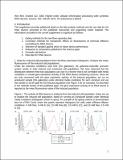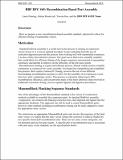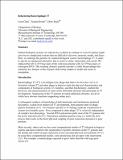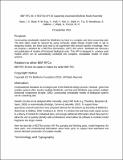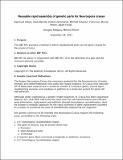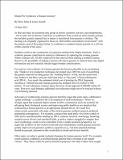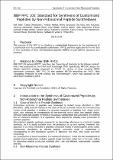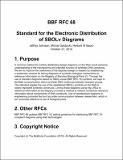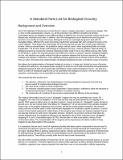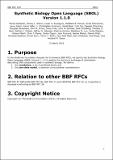Browsing Synthetic Biology by Title
Now showing items 111-130 of 139
-
RA-PCR, a method for the generation of randomized promoter libraries
(2009-10-21)The purpose of this RFC is to provide instructions for the synthesis of promoters in mammalian cells that are active at a desired cellular condition (where a cellular condition is specified by the activity of a set of ... -
Rapid Characterization of Cellular Pathways Using Time-Varying Signals
(International Conference on Systems Biology, 2005-10-21)The use of traditional tools for the discovery and characterization of biological systems has resulted in a wealth of biological knowledge. Unfortunately, only a small portion of the biological world is well-understood ... -
Raw Data, Win MN, Smolke CD. 2008. Higher-order cellular information processing with synthetic RNA devices. Science. 322: 456-60. DOI: 10.1126/science.1160311
(2009-07-29)This supplement provides additional detail on the data analysis methods and the raw data for the RNA devices presented in the published manuscript and supporting online material. The information provided in the current ... -
Recombination Based Part Assembly
(2010-12-05)Here we propose a new recombination-based assembly standard, optimized to allow for efficient cloning of mammalian vectors. -
Refactoring Bacteriophage T7 (2004 version)
(2004-10)Natural biological systems are selected by evolution to continue to exist. Evolution might give rise to complicated systems that are difficult to discover, measure, model, and direct. Here, we redesign the genome of a ... -
Registry of BioBricks Models using CellML
(2007-10-04)One of the main goals in Synthetic Biology is to assess the feasibility of building novel biological systems from interchangeable and standardized parts. In order to collect and share parts, a Registry of standardized DNA ... -
A RESTful API for Supporting Automated BioBrick Model Assembly
(2010-12-05)Constructing simulatable models for BioBricks by hand is a complex and time-consuming task. The time taken could be reduced by using Computer Aided Design (CAD) tools to aid in designing models, but these tools need to be ... -
Reusable rapid assembly of genetic parts for Neurospora crassa
(2011-10-17)This BBF RFC provides a method in which standardized parts can be easily created for Neurospora crassa. -
Risk Assessment of Synthetic Genomics: A Biosafety and Biosecurity Perspective
(2007-12-04)The ability to synthesize molecules found in living organisms is not new for scientists in the fields of biochemistry and molecular biology. However, the “synthetic biology” made possible by the genetic mapping of ... -
A Roadmap to the Assembly of Synthetic DNA from Raw Materials
(2007-12-04)Until recently, the synthesis of DNA has been a tedious, time consuming, expensive and experimentally challenging task. But advances in automated instrumentation and improved chemistry have now made it possible to make ... -
Sequence Screening
(2007-12-04)Currently the vast majority of DNA synthesis is performed by service companies or by in-house central facilities in universities and large companies. The DNA synthesis industry provides researchers with custom DNA at ... -
Should We Synthesize A Human Genome?
(2016-05-10)Given that human genome synthesis is a technology that could be used to completely redefine the core of what now joins all of humanity together as a species, we argue that discussions of making such capacities real, like ... -
Simulation, Models, and Refactoring of Bacteriophage T7
(2007-02-02)Our understanding of why biological systems are designed in a particular way would benefit from biophysically-realistic models that can make accurate predictions on the time-evolution of molecular events given arbitrary ... -
Software files to support thesis of Ty Thomson
(2008-05-21) -
Standard Biological Part Automatic Modeling Database Language (MoDeL)
(2010-11-09)This BioBricks Foundation Request for Comments (BBF RFC) describes the Standard Biological Part Automatic Modeling Database Language (MoDeL). MoDeL provides a language and syntax standard for automatic modeling databases ... -
Standard for Synthesis of Customized Peptides by Non-Ribosomal Peptide Synthetases
(2013-10-04)The purpose of this RFC is to introduce a standardized framework for the engineering of customizable non-ribosomal peptide synthetases (NRPS) and their application for in vivo and in vitro synthesis of short non-ribosomal ... -
Standard for the Electronic Distribution of SBOLv Diagrams
(2010-12-05)A common method for publicly distributing design diagrams on the Web would enhance understanding of the mechanisms and intended function of synthetic DNA constructs. We aim to improve the usefulness of the depicted design ... -
A Standard Parts List for Biological Circuitry
(DARPA White Paper, 1999-10-07)One of the hallmarks of biochemical circuits found in nature is analog, asymmetric, asynchronous design. That is, there is little standardization of parts, e.g. all the promoters have different strengths and kinetics, ... -
Strategy for Biological Risk & Security
(2003-10)Why do biological risks exist? Can we develop and implement a strategy for thoughtfully approaching future biological risks? This short, working report provides an abstract introduction to the problem of biological risk ... -
Synthetic Biology Open Language (SBOL) Version 1.1.0
(2012-10-11)In this BioBricks Foundation Request for Comments (BBF RFC), we specify the Synthetic Biology Open Language (SBOL) Version 1.1.0 to enable the electronic exchange of information describing DNA components used in synthetic ...

